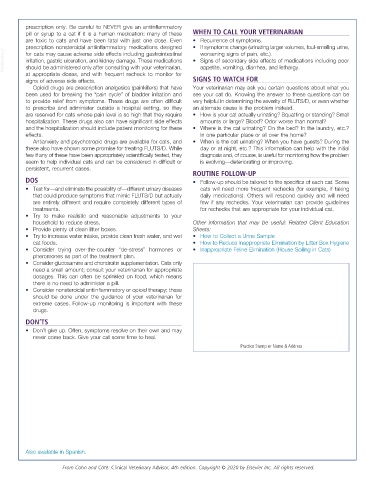Page 3000 - Cote clinical veterinary advisor dogs and cats 4th
P. 3000
prescription only. Be careful to NEVER give an antiinflammatory
pill or syrup to a cat if it is a human medication; many of these WHEN TO CALL YOUR VETERINARIAN
are toxic to cats and have been fatal with just one dose. Even • Recurrence of symptoms.
prescription nonsteroidal antiinflammatory medications designed • If symptoms change (urinating larger volumes, foul-smelling urine,
VetBooks.ir irritation, gastric ulceration, and kidney damage. These medications • Signs of secondary side effects of medications including poor
worsening signs of pain, etc.).
for cats may cause adverse side effects including gastrointestinal
appetite, vomiting, diarrhea, and lethargy.
should be administered only after consulting with your veterinarian,
at appropriate doses, and with frequent recheck to monitor for
signs of adverse side effects. SIGNS TO WATCH FOR
Opioid drugs are prescription analgesics (painkillers) that have Your veterinarian may ask you certain questions about what you
been used for breaking the “pain cycle” of bladder irritation and see your cat do. Knowing the answer to these questions can be
to provide relief from symptoms. These drugs are often difficult very helpful in determining the severity of FLUTS/D, or even whether
to prescribe and administer outside a hospital setting, so they an alternate cause is the problem instead.
are reserved for cats whose pain level is so high that they require • How is your cat actually urinating? Squatting or standing? Small
hospitalization. These drugs also can have significant side effects amounts or large? Blood? Odor worse than normal?
and the hospitalization should include patient monitoring for these • Where is the cat urinating? On the bed? In the laundry, etc.?
effects. In one particular place or all over the home?
Antianxiety and psychotropic drugs are available for cats, and • When is the cat urinating? When you have guests? During the
these also have shown some promise for treating FLUTS/D. While day or at night, etc.? This information can help with the initial
few if any of these have been appropriately scientifically tested, they diagnosis and, of course, is useful for monitoring how the problem
seem to help individual cats and can be considered in difficult or is evolving—deteriorating or improving.
persistent, recurrent cases.
ROUTINE FOLLOW-UP
DOS • Follow-up should be tailored to the specifics of each cat. Some
• Test for—and eliminate the possibility of—different urinary diseases cats will need more frequent rechecks (for example, if taking
that could produce symptoms that mimic FLUTS/D but actually daily medications). Others will respond quickly and will need
are entirely different and require completely different types of few if any rechecks. Your veterinarian can provide guidelines
treatments. for rechecks that are appropriate for your individual cat.
• Try to make realistic and reasonable adjustments to your
household to reduce stress. Other information that may be useful: Related Client Education
• Provide plenty of clean litter boxes. Sheets:
• Try to increase water intake, provide clean fresh water, and wet • How to Collect a Urine Sample
cat foods. • How to Reduce Inappropriate Elimination by Litter Box Hygiene
• Consider trying over-the-counter “de-stress” hormones or • Inappropriate Feline Elimination (House Soiling in Cats)
pheromones as part of the treatment plan.
• Consider glucosamine and chondroitin supplementation. Cats only
need a small amount; consult your veterinarian for appropriate
dosages. This can often be sprinkled on food, which means
there is no need to administer a pill.
• Consider nonsteroidal antiinflammatory or opioid therapy; these
should be done under the guidance of your veterinarian for
extreme cases. Follow-up monitoring is important with these
drugs.
DON’TS
• Don’t give up. Often, symptoms resolve on their own and may
never come back. Give your cat some time to heal.
Practice Stamp or Name & Address
Also available in Spanish.
From Cohn and Côté: Clinical Veterinary Advisor, 4th edition. Copyright © 2020 by Elsevier Inc. All rights reserved.

